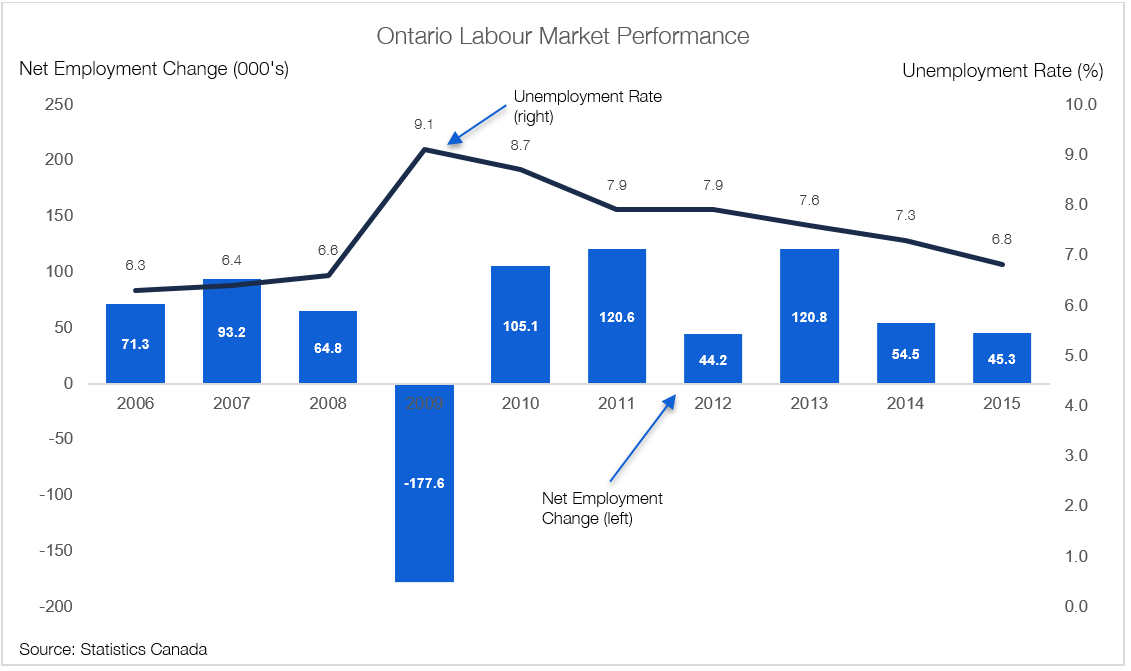On January 8, Statistics Canada (StatCan) released the Labour Force Survey (LFS) for December 2015, providing the first complete annual estimate of the economy’s performance in 2015. The release showed that while Ontario posted a solid job gain in December (+35,000 jobs on a month-to-month basis), on an annual basis, Ontario’s labour market continued to grow modestly in 2015.
- According to the survey, total employment in Ontario increased by 45,000 jobs[1] (+0.7%) in 2015, matching the weakest annual job gain since the 2009 recession. The result, while in line with the Government of Ontario’s November Economic Outlook and Fiscal Review projection of 46,000, is particularly disappointing when compared to forecasts prepared 9 months ago which called for job growth almost twice as large as the actual outcome for the year.
- The 2015 Budget predicted a gain of 78,000 net new jobs (+1.1%) in 2015, consistent with the outlooks of independent economists in early 2015. The subsequent November revision reflected a slower than expected pace of economic growth in 2015.
- The 2015 Budget predicted a gain of 78,000 net new jobs (+1.1%) in 2015, consistent with the outlooks of independent economists in early 2015. The subsequent November revision reflected a slower than expected pace of economic growth in 2015.
- Ontario’s unemployment rate averaged 6.8% in 2015, slightly better than the Budget prediction of 6.9%, and down significantly from 7.3% in 2014. The continued decline in Ontario’s unemployment rate last year was largely a reflection of weak labour force growth (+0.1% in 2015) as many Ontarians chose to leave the labour market, often because they have decided to retire, but also because many are discouraged by their job prospects and have quit looking for work altogether.
- Looking beyond the headline LFS numbers reveals some additional interesting results for 2015.
- Much of the overall gain in employment in 2015 was driven by a strong 33,000 increase (+3.1%) in the number of self-employed Ontarians, the largest gain since 2007. The increase in self-employment reflects shifts in the nature of work but could also signal underlying weakness in the economy -- with employers failing to generate enough jobs, forcing workers to create their own employment opportunities.
- Private sector employment increased by a modest 24,000 jobs (+0.5%) in 2015, offsetting a decline of 11,000 jobs (-0.9%) in the public sector.
- Full-time employment was up by a solid 78,000 jobs (+1.4%) and was offset by a loss of 33,000 part-time jobs (-2.5%).
- Much of the overall gain in employment in 2015 was driven by a strong 33,000 increase (+3.1%) in the number of self-employed Ontarians, the largest gain since 2007. The increase in self-employment reflects shifts in the nature of work but could also signal underlying weakness in the economy -- with employers failing to generate enough jobs, forcing workers to create their own employment opportunities.

-
- The composition of the job gains by industry was largely consistent with the broad developments in the Ontario economy last year. Manufacturing employment declined for the third consecutive year, slipping by 4,000 jobs (-0.5%) in 2015 while construction employment surged by 20,000 net new jobs (+4.3%), reflecting in part, the continued strength of residential construction last year.
- Despite the moderate job growth, average hourly wages posted very solid gains, increasing by over 3.1% in 2015, the strongest annual gain in average wages since 2008.
- The composition of the job gains by industry was largely consistent with the broad developments in the Ontario economy last year. Manufacturing employment declined for the third consecutive year, slipping by 4,000 jobs (-0.5%) in 2015 while construction employment surged by 20,000 net new jobs (+4.3%), reflecting in part, the continued strength of residential construction last year.
- While the LFS is the highest profile source of labour market information in Canada, StatCan also produces the Survey of Employment, Payrolls and Hours (SEPH). The SEPH data presented a stronger picture of Ontario employment gains in 2015, reporting an increase of 115,000 workers (+2.0%) on a year-over-year basis up to October - a significantly stronger job gain than indicated by the LFS data. Historically, small differences between the two surveys have been common and have tended to cancel out over time. However, the large difference between the two surveys in 2015 is unusual and is something to keep an eye on when annual SEPH data is released in February, particularly given the strong December job gain indicated by the LFS release.
| David West | dwest@fao-on.org |
| Nicolas Rhodes | nrhodes@fao-on.org |
Financial Accountability Office of Ontario
January 8, 2016
416-254-9232
kbaun@fao-on.org
[1] Statistics Canada reported a year-over-year employment gain of 81,000 jobs for Ontario. This commentary focuses on annual average employment gains. This is a more stable indicator and is the employment indicator referenced in the Ontario budget.
Ontario Labour Market Performance
This chart shows the net employment change and the unemployment rate from 2006 to 2015. The unemployment rate which spiked at 9.1 per cent in 2009, has since slowly and consistently trended downward, reaching a value of 6.8 per cent in 2015. The net employment change has been positive in every year except 2009, when employment levels fell -177,600. In 2015, employment grew by 45,300 jobs.







